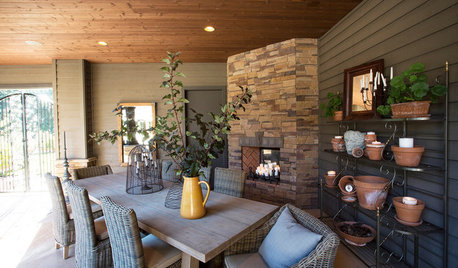how do I tie off an unused switch?
mocknbird
11 years ago
Related Stories

GARDENING AND LANDSCAPING3-Season Rooms: From Unused Space to Fab Outdoor Kitchen
Clean lines, a serious grill and even a Kegerator make this Oregon outdoor room a spring-to-fall joy
Full Story
FIREPLACESA Dozen Ways to Style an Unused Fireplace
You'll hardly miss the flame when your firebox glows with twinkle lights, frames an art object or stores magazines
Full Story
DECORATING GUIDESSwitching Up a Colonial Home to Suit a Modern Family
Floor plan labels are thrown out the window as a designer helps a family shape rooms to fit the way they live
Full Story
GREEN BUILDINGOff the Grid: Ready to Pull the Plug on City Power?
What to consider if you want to stop relying on public utilities — or just have a more energy-efficient home
Full Story
MOST POPULARHouzz Tour: Going Off the Grid in 140 Square Feet
WIth $40,000 and a vision of living more simply, a California designer builds her ‘forever’ home — a tiny house on wheels
Full Story
HOUZZ TOURSHouzz Tour: Just What Mom Wanted, Off the Washington Coast
With an art studio, age-in-place features and a view-maximizing design, this home shows just how well the architect knows his client
Full Story
DECORATING GUIDES8 Reasons to Jump Off the DIY Bandwagon
You heard right. Stop beating yourself up for not making stuff yourself, and start seeing the bright side of buying from others
Full Story
LIFEHouse Rule: Off With Your Shoes
Do you prefer your guests to go shoeless in your house? Here are some ways to encourage stockinged feet
Full Story
GREEN BUILDINGHouzz Tour: Going Completely Off the Grid in Nova Scotia
Powered by sunshine and built with salvaged materials, this Canadian home is an experiment for green building practices
Full Story
DECORATING GUIDESHow to Pull Off a Minimalist Look Without Sacrificing Your Style
Minimalism doesn’t always mean white and characterless — it’s about playing favorites
Full StoryMore Discussions










brickeyee
mocknbirdOriginal Author
Related Professionals
Evans General Contractors · Fargo General Contractors · Kyle General Contractors · Las Cruces General Contractors · Post Falls General Contractors · Saint George General Contractors · Westchester General Contractors · Muscatine Solar Energy Systems · Tarpon Springs Solar Energy Systems · New Lenox Solar Energy Systems · Lincolnwood Home Automation & Home Media · Oak Lawn Home Automation & Home Media · Saint Petersburg Home Automation & Home Media · West Chester Home Automation & Home Media · Sugar Hill Home Automation & Home Mediawestom
Ron Natalie
brickeyee
mocknbirdOriginal Author
brickeyee
lazy_gardens
brickeyee
Ron Natalie
brickeyee
eam44
brickeyee
eam44
greg_2010
eam44
greg_2010
rbumpersxk1